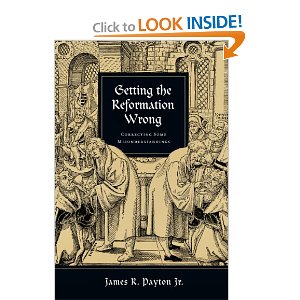James R. Payton, Getting the Reformation Wrong.
Correcting some Misunderstandings, (Downers Grove: InterVarsity Press, 2010), 240
pages, $23.
History
is unquestionably messy and complex, and this is all the more the case when one
is considering some of the most turbulent and momentous epochs in history. One such period is the Reformation, and James
R. Payton, professor of history at Redeemer University College in Ancaster
Ontario, is determined to demonstrate to us how we have gotten various things
wrong about the period called the Reformation.
Like
any good historian, Payton insists that we study the Reformation in its proper
context, which is to say in light of the previous era of the Middle Ages and
the Renaissance. This is why he spends
the first two substantial chapters of the book giving us a précis about those
two eras insofar as they have a bearing on how we should interpret the Reformation.
For example, he stresses that there was already a considerable outcry for
reformation of the church in both of these eras, and a few efforts at affecting
such a change. Western Christendom knew
things were not well and kept calling for ‘reformatio in capite et
membris’–‘reformation in head and members’. The problem was, those who heard
the cry and could do something about it, largely ignored it or practiced call
forwarding.
In his chapter about the
Renaissance, one of the best in this
helpful study, Payton rightly notes that
the ‘humanism’ that arose in this period was not in fact the forebear of modern
secular humanism. It was rather a
reaction to scholasticism and an attempt to recover the wisdom of antiquity,
through the study of what we today call the Greek and Latin classics, but also
through the study of the master works of the patristic fathers as well. As Payton rightly points out, humanists like Petrarch or Erasmus were not
attempting to shake themselves free from the shackles of Christianity. Rather, in the case of most of these
humanists, they were sincere Christians who wrote treatises about both the
‘classics’ and about Christian antiquity
as well. What they were reacting to was
the stifling legacy of medieval scholasticism.
This
book is very well written, and remarkably free of typos (but see p. 116 line
10), and beginning with the third chapter
(pp. 72ff.) Payton really turns to the meat of his subject–the ways in
which even we Protestants have gotten the Protestant Reformation wrong. At the epicenter of the early chapters of
this part of the book is of course that former Augustinian monk, Martin
Luther. Payton skillfully reminds us
that Luther, despite all his fulminating against scholastic scholarship of
various sorts was himself a product of a Catholic scholastic education, had an
earned PhD,and unlike various of the other Reformers (e.g. Erasmus,
Melanchthon, Bucer) was not a part of the humanist movement that wanted to get
back behind the medieval ways of arguing and doing theology.
Indeed, Luther used the very same sorts of
invective, polemics, character attacks and the like that were all too common in
scholastic debates. In this regard, he
was very different from various of his fellow Reformers. Luther, for example, unlike Melanchthon was not trained in
rhetoric, nor did he read the NT in a rhetorical manner, for the most
part. It is thus all the more ironic
that Luther saw Rom. 1.16-17 as the crucial thesis statement of Romans,
which trumpeted the great truth of
justification by grace through faith alone. What is ironic about this is that rhetorical analysis shows that this is indeed the ‘propositio’ of Romans.
Luther however was not a social reformer,
and when the Peasant Revolt emerged, he was for its violent suppression. His theology of two kingdoms, with the realm
of rulers and knights being part of kingdom No. 2 which could not be expected
to run on Christian principles, set him at odds with other Reformers,
especially the more radical ones. He was
a champion of church reform, not of state reform. In this regard, he was quite different from many modern Evangelicals.
Chapter
4 succinctly chronicles how, while the Reformers all generally agreed on
justification by grace through faith, and on the notion of Scripture as the
ultimate norm, there were in fact many crucial
subjects, on which they had heated disagreements, for example about the
Lord’s Supper.
The most crucial chapters
in this book however are Chapters 5-6 which deal with the two banner notions of
sole fide and the notion of sole scriptura
(pp. 115-59). These chapters
repay close scrutiny. One of the things
Payton is exercised to demonstrate in Chapter 5 is that the Reformers did not
think that ‘faith’ was ever alone. It
was always accompanied by the work of the Spirit, and the enabling to do good
works (though they were not viewed as salvific). The Reformers did not think that merely
notional assent to the proposition that Jesus is Lord was all there was to
being saved.
Perhaps the oddest part of
the book is pp. 127-30 where Payton is critical of camp meetings and revivals
in North America, where, he suggests, the notion was promulgated that a crisis experience and a
moment of ‘decision for Christ’, even if followed by a dissolute life, had
nonetheless saved the person for all eternity.
It is hard to know what sort of revivals he is thinking of—- certainly
not the Methodist and holiness revivals which stressed not only conversion but
holiness of heart and life. It may be
that we have been getting some things wrong about the Reformation, but Payton
is just as guilty of getting some things wrong about the Camp meetings and
revivals of the 19th-20th centuries.
In
Chapter 5, Payton rather easily
demonstrates that the Reformers did not mean by sola Scriptura that Scripture
was the only norm for the church. To the contrary they also saw the ancient
creeds, the ecumenical councils and the wisdom of the ancient church fathers as
norms of a lesser sort as well. In this
respect the Protestant Reformers stand quite apart from some modern
Evangelicals who seem to think that their forebears insisted that the Bible
alone is the authority and norm for the church.
While the Reformers agreed that the canon
should be the measuring rod for all else and the super norm of all other norms,
they did not think that the Bible was the sole authority in and for the church.
It is somewhat surprising that in an
otherwise excellent chapter Payton takes a potshot at the NIV as if its
translators had fallen prey to the ‘Scripture good, tradition bad’
caricature. Having personally known
many of the NIV translators and their views, I can say without fear of contradiction,
this was not the view of the translators like Doug Stuart and Gordon Fee who
taught me.
Chapters
7-9 explain how the Anabaptists fit into this larger picture (they were not a
unified group and are the forebears of the Mennonites and the Amish, but not so
much the Baptists in America, who were more indebted to the English
Baptists). What is striking is that in
the big ‘baptism’ controversy, every single one of the major Reformers—
Luther, Calvin, Melanchthon, Bucer, Beza, Knox, Cranmer, Wesley all were
convinced that infant baptism was a good Biblical practice. Adult baptism was not a doctrine of the major
Protestant Reformers. Indeed, one could
argue that while the Baptists owed something to the Radical Reformation, they
were part of a different renewal movement than what has come to be called the
Protestant Reformation.
To his credit (in
chapter 8) Payton covers the
Counter-Reformation launched in large part by the Jesuits,, against the
Protestant Reformation, with the result that many of the successes of the
Protestant movement in eastern and central and western Europe were reversed by
the Jesuits. How did they do it? By
founding great Christian schools that even the Protestants wanted to send their
children to, children who mostly were
converted back to Catholicism in these schools.
Payton also covers in chapter 9 the rise of Protestant
scholasticism after the time of the great Reformers, and here again he is on
target in his critique of the successors
of Luther and Calvin and the other Reformers who resorted to a scholastic
method of systematizing and atomizing the Biblical text in ways that departed from the modus operandi of the
Reformers and indeed from some of their theological conclusions as well. Those responsible for the Reformed take over of the Southern Baptist convention, or at least various of its seminaries, would do well to pay close attention to this chapter.
In chapter 10, entitled ‘Did the
Reformation Succeed?’ Payton
demonstrates, reformer by reformer that each of the major reformers would not
have been able to answer yes to that question. Indeed, many of them died
prematurely or died disillusioned with the outcome, and that includes
Luther.
Had Payton extended his study,
as he should have done, to the English Reformation, he would have come to the person of John
Wesley—- who witnessed, affirmed, and was indeed excited about, to his dying
day, the incredible success of the Wesleyan rev ival, a revival that went on
for over two generations and did not degenerate into some sort of theological
scholasticism. Wesley was well satisfied
with the Methodist revival’s ability to
transform various aspects of both English and then American culture, and indeed
would have seen Wilberforce’s remarkable success in ending the slave trade in
England not long after his death as a further example of how the Gospel could affect
both spiritual and social transformation.
The difference between Wesley and the earlier Reformers is that Wesley
did not set himself up in opposition to the Catholic Church, did not spend his time in continual
theological bickering, did not see
himself in apocalyptic terms, nor did he see himself as a prophet predicting on
the near horizon the return of Christ.
This is not to say Wesley was unconcerned
about orthodoxy, but the orthodoxy he was concerned about was what the Bible
clearly taught, or its clear implications.
In fact, he would reject major tenants of the theological platforms of
the previous Reformers (e.g. Luther’s
‘bondage of the human will’ idea and his two kingdoms notion, Calvin’s predestination and eternal security,
Zwingli’s under emphasis on the real presence of Christ in the Eucharist, the
Anabaptists repudiation of infant baptism etc.). Payton’s study is excellent in what it
covers in various ways, but it ignores
the last full flowering of the Reformation in England and then America.
In Chapters 11-12 which conclude
this study Payton is able to demonstrate that the Reformation period should not
in itself be seen as a norm, or as some golden age of church history that we
should seek to imitate in detail. He
also shows that a balanced appreciation of the Reformation allows that it produced
both triumphs (getting back to the heart of the Gospel of justification by
faith) and tragedies, the latter being a movement that has now splintered into
some 26,000 or more different
denominations. It is a mark of a good study that it produces
this sort of extended response. In view of
the fact that this book is well under 300 pages, Payton would have done well to have finished
the job— by dealing with the English Reformation that followed the
Continental one. Had he done so, he
might well have been able to modify some of his more negative conclusions.
Dr. Ben Witherington, III
Amos Professor of NT for Doctoral Studies, ATS (and one time professor of Biblical and
Wesleyan Studies in several other seminaries).


